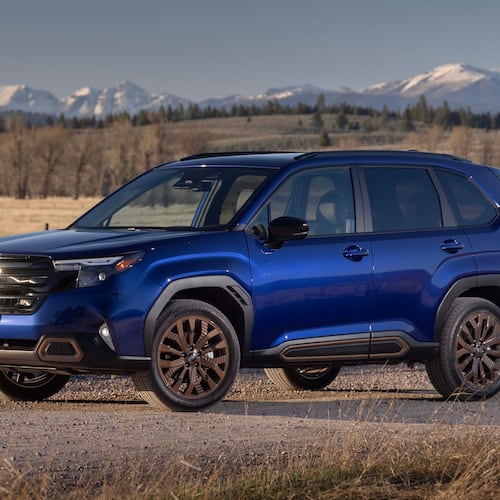Stellantis is adding another automotive feather to Georgia’s cap with a more than $41 million investment in an auto parts distribution center planned for Forsyth, about 60 miles south of Atlanta.
The 422,000-square-foot facility will serve dealers and customers across the Southeast and support about 90 union jobs. Construction is set to start in 2026, with completion expected in 2027.
The facility will be part of Stellantis’ Mopar network. Mopar is its global parts, accessories and customer‑care brand supporting Chrysler, Dodge, Jeep, Ram, Alfa Romeo and Fiat with genuine parts, accessories and service.
At the heart of the operation in Monroe County will be a 16,000-square-foot AutoStore automated storage and retrieval system — a high-density grid of bins worked by 66 robots that will ferry parts to processing stations.
The setup is designed to increase accuracy, speed orders and turn inventory faster while reducing the footprint needed for storage. Stellantis said the building will use energy-saving technologies and sustainable practices to minimize its operational footprint.
“This facility represents a critical investment in Mopar’s long‑term growth strategy … while supporting our commitment to efficiency and sustainability,” Darren Bradshaw, senior vice president of Mopar North America, said in a written statement.
Network expansion
The Forsyth parts distribution center will consolidate regional operations as part of a larger reshaping of the company’s after-sales footprint.
In July, Stellantis announced a $388 million metro Detroit “megahub,” its largest parts facility project to date, and earlier this year it opened a $64 million parts center in East Fishkill, New York. Together, these investments approach $500 million, demonstrating that parts logistics is now as strategic as vehicle assembly.
What it means for drivers
For Georgia consumers, the potential upside is faster parts availability and shorter repair times, fewer return visits when shipments slip and less time in a loaner or rental car.
A large parts facility along the I-75 corridor improves next-day delivery into metro Atlanta and surrounding markets while extending reach across neighboring states. When a back-ordered camera, control module or bumper cover becomes a one-day shipment instead of a multiweek wait, customers feel it.
Older cars, rising repairs
This investment lands as many households are keeping vehicles longer. Estimates put the average age of vehicles on U.S. roads at about 12.8 years — a record high — pushed up by elevated new-car prices and higher interest rates. Faced with the math of a new payment, owners increasingly get repairs to extend the life of a paid-off vehicle.
That choice, repeated across millions of driveways, pressures the parts pipeline for wear items like brakes and tires and for pricier components such as alternators, catalytic converters and driver-assistance sensors.
Boost for independent shops
Dealers and independent shops depend on strong fill rates — the share of orders fulfilled immediately. Better distribution by manufacturers lets service providers quote timelines with more confidence and keeps technicians productive instead of waiting on boxes.
Even when a repair is complex, predictable delivery windows help sequence work, reduce returns tied to incorrect parts and keep bays turning.
Georgia’s growing auto footprint
The project deepens Georgia’s automotive ecosystem.
Hyundai Motor Group opened the initial phase of its massive manufacturing complex near Savannah last year. In West Point, Kia continues to build vehicles, including the Telluride, Sorento, Sportage, EV6 and EV9 SUVs, and the K5 sedan.
Porsche and Mercedes-Benz each base their North American headquarters in metro Atlanta; Porsche’s customer experience center is an enthusiast magnet, and Mercedes-Benz is expanding research and development in the state.
With the Port of Savannah, Hartsfield-Jackson’s cargo capacity and interstate access, Georgia’s logistics backbone looks tailor-made for parts distribution.
Jobs and ripple effects
The immediate job count — about 90 union roles — may be modest next to an assembly plant, but parts facilities carry multiplier effects. They support freight carriers, packaging suppliers, building services and maintenance contractors. Just as important, after-sales demand tends to be steadier than new-vehicle cycles. People maintain cars in boom times and stretch them in lean times. Either way, parts move.
Expectations and limits
Not every repair will be instantaneous, and specialized components like certain electronic modules, unique trim pieces or structural parts can still require lead time. Collision supply chains tighten when severe weather drives a spike in claims.
But a major Mopar parts facility in Forsyth should shift the average experience in the right direction: fewer delays, more accurate parts on the first try and clearer communication about timelines.
Why it matters
In that sense, this is both a jobs story and a consumer story. As Georgians weigh whether to buy new or keep what they own, a stronger parts network can quietly tip the scales toward repair when it makes financial sense.
Keeping vehicles on the road safely and efficiently is good business — for automakers, dealers, independent shops and, most important, the drivers who depend on their cars to get to work, school and everywhere in between.
Brian Moody is a senior editor of Kelley Blue Book and Autotrader, and an automotive expert specializing in transportation, car shopping, electric cars, in-car technology and future vehicles.
The Steering Column is a weekly consumer auto column from Cox Automotive. Cox Automotive and The Atlanta Journal-Constitution are owned by parent company, Atlanta-based Cox Enterprises.
About the Author
Keep Reading
The Latest
Featured


